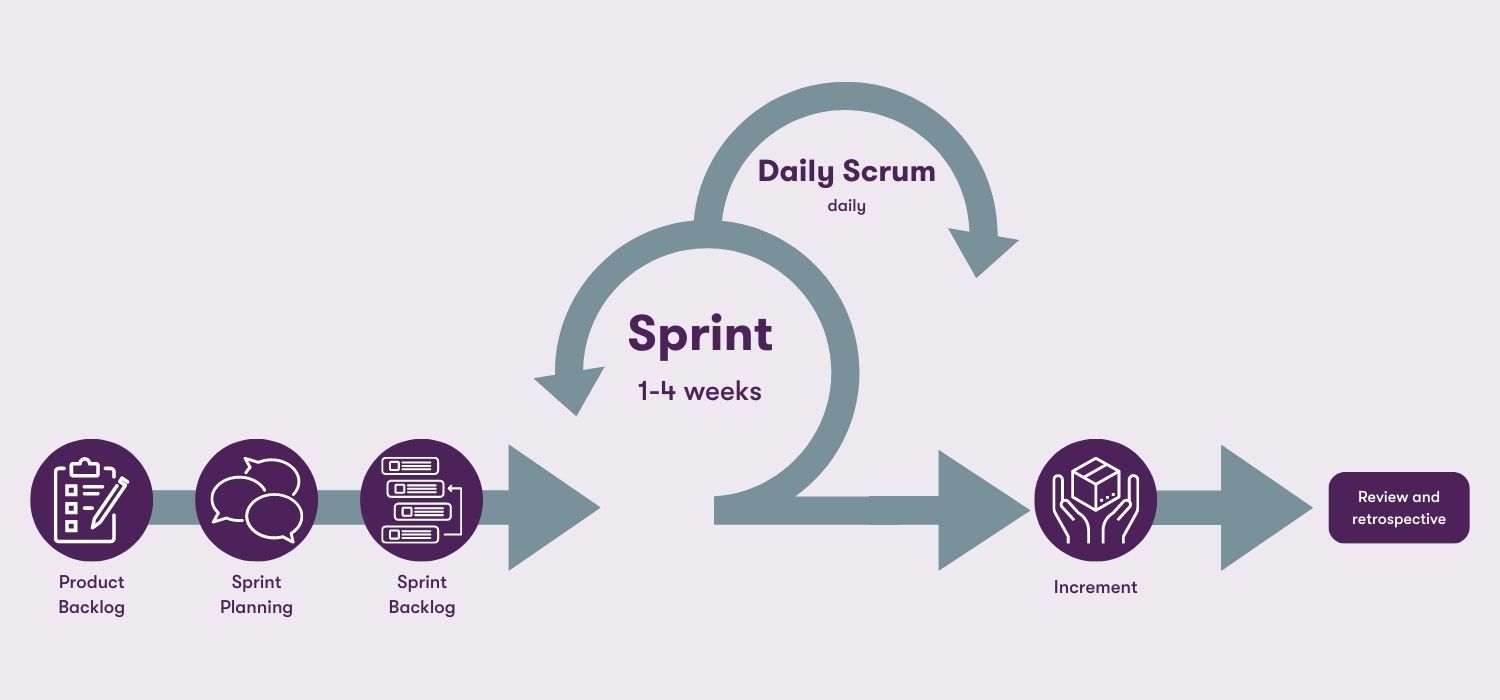Scrum in project management: basics and approach
If you work in a product, development or software development team or collaborate with one of these teams, you have probably heard the term "Scrum" before. You may be asking yourself the question: What exactly is Scrum all about and how is this methodology successfully applied in project management? Scrum is an agile framework for product development that enables teams to work more efficiently and adapt flexibly to changing requirements. The importance of agile methodologies like Scrum lies in their ability to accelerate the development process, foster collaboration and focus on customer needs. In this context, we would like to give you a closer look into the world of Scrum and explain how this agile method works.
Scrum Basics
Scrum is an agile project management method developed to improve efficiency and flexibility in product development. The genesis of Scrum dates back to the 1990s, when Jeff Sutherland and Ken Schwaber developed this method in response to the challenges of traditional, sequential project management approaches.
In today's fast-paced business environment, where requirements and conditions change frequently, the rigid and plan-driven approach proved insufficient. Scrum was conceived as a response to these dynamics and focuses on an iterative, incremental and customer-centric approach. The basic idea behind Scrum is that teams are better able to deal with uncertainties and continuously deliver high-quality products if they organize themselves, work independently and regularly check in with the product progress.
The three pillars of Scrum
- Transparency: Transparency means that all relevant information about the progress and obstacles of the project should be accessible to all team members. Open communication within the team creates a shared knowledge base that facilitates collaboration and decision making.
- Review: review occurs at regular intervals, typically in short, time-bound iterations called "sprints." In these sprints, the product is developed incrementally, and at the end of each sprint, there is an assessment of progress made and customer satisfaction.
- Adjustment: Based on the results of the review, the course of the project is adjusted, if necessary, to ensure that the final product meets the current requirements and needs of the customer or client.

Scrum vs. Kanban vs. Agile
"Scrum" and "Kanban" are two popular agile methods used in different contexts. The main difference between them lies in their approach to project management. Scrum, with its structured framework of fixed roles and tools such as sprints, is particularly well suited for projects with clear goals and tightly defined requirements, as it allows for regular and predictable delivery of increments. The Kanban method, on the other hand, focuses on continuous processes and visual boards to manage tasks. For example, the Kanban board provides the ability to visualize how tasks move from one phase of work to the next until they are finally completed. Often, teams that use Scrum also use Kanban boards.
The Scrum Framework
The Scrum Framework is the core of the agile Scrum method and enables teams to approach tasks efficiently and flexibly. It is made up of several important elements that, in close interaction, enable the successful completion of tasks.
Sprint
The sprint is a central component of the Scrum framework. It represents a fixed time window in which the development team works on implementing the tasks defined in the product backlog. Typically, a sprint lasts one to four weeks, with the team aiming to present the solved problem at the end of the sprint.
Product Backlog
The Product Backlog is a list of all the work that needs to be done. The product owner is responsible for managing and prioritizing the backlog. New requirements can be added, existing ones refined, and unwanted items removed.
Sprint Planning
Sprint Planning is an important meeting that marks the beginning of each Sprint. Here, the development team works closely with the product owner to define the objectives to be achieved in the sprint. The highest-priority items in the product backlog are carried over into the sprint, and the team plans the necessary steps and tasks to achieve the objective.
Sprint Backlog
The Sprint Backlog is a list of tasks to be implemented during the Sprint period. These tasks are selected from the Product Backlog. The development team selects the tasks in the Sprint Backlog that they can work on during the current Sprint to achieve the goals set in the Sprint. The Sprint Backlog is constantly updated and may change during the Sprint as new information or requirements emerge or priorities shift.
Daily Scrum
The Daily Scrum is a short, time-limited meeting that takes place every day. In this meeting, the development team shares and discusses the progress of the work that has been done since the last Daily Scrum, upcoming tasks, and potential roadblocks. This meeting is used to coordinate and identify issues to ensure the team stays on track.
Increment
The increment is the result of a sprint. This is ultimately a small part of the final desired result. Each increment should therefore be potentially deliverable and meet the established definitions of "Done". This means that the finished work elements have the required quality and are ready for delivery to customers.
Sprint Review
At the end of each sprint, the sprint review takes place. The development team presents the increment of the sprint to the product owner and other interested stakeholders. This review provides an opportunity to gather feedback and ensure that the outcome meets expectations and meets customer needs.
Sprint Retrospective
The sprint retrospective is a reflection task that takes place after each sprint. Here, the team analyzes together what worked well and what can be improved. This continuous improvement optimizes the process and increases the efficiency and effectiveness of the team.

Scrum Roles
In the Scrum framework, there are three main roles that carry clearly defined responsibilities and ensure the smooth implementation of the method.
Product Owner
The product owner is a central key role in the Scrum team. He or she defines the requirements that are recorded in the product backlog. It is important to prioritize the requirements according to their importance and urgency in order to achieve the greatest possible customer benefit. The product owner is in close contact with the customer and the development team and ensures that the desired functions and features are understood and implemented correctly.
Scrum Master
The Scrum Master plays a crucial role in introducing and maintaining the agile way of working in the Scrum team. He or she is responsible for ensuring that the team understands and effectively applies the Scrum principles and processes. The Scrum Master supports the team in working in a self-organized and self-reliant manner and leads the daily standup meetings as well as the sprint planning, review and retrospective meetings.
Scrum Team
The Scrum team is the group of professionals who work together to solve a problem and are responsible for implementing the goals set in the sprint. It consists of developers, designers or other experts. The team organizes itself and decides independently how the requirements of the product backlog are implemented in a sprint. The members of the Scrum team work closely together and exchange ideas continuously to achieve the best possible result. They work in close cooperation with the product owner and the scrum master to ensure that the result meets the requirements and expectations of the customer.
The five central values of Scrum
The five core values of Scrum are the basic principles that shape the behavior of the team members and their collaboration.
- Courage: During a sprint, the team may encounter problems for which there is no concrete solution. However, Scrum teams dare to ask open and tough questions and answer them honestly.
- Focus: The team works based on a product backlog in each sprint. In doing so, the team focuses on the elements from the backlog to achieve the desired results at the end of the sprint.
- Commitment: The team works together as a unit, whereby the team members must be able to trust each other. Scrum team members excel in their commitment for the duration of the sprint and dedicate themselves to continuous improvement to ultimately find the best solution.
- Respect: The key to a successful Scrum process is collaboration. And to support team collaboration, team members must respect each other, the Scrum Master, and the Scrum process.
- Openness: In a Scrum process not everything always runs perfectly. Therefore, team members must be open to new ideas and possibilities. This supports both the individual learning process and the product or process itself.
By living these values, the team can work together more effectively, resolve conflicts constructively, and overcome obstacles, ultimately increasing productivity and the quality of the product.
The advantages of Scrum
- Flexibility: Scrum makes it possible to meet rapidly changing customer requirements.
- Transparency: Through regular meetings and reviews, customers and stakeholders are always informed about the progress of the project.
- Continuous improvement: The sprint retrospectives promote continuous improvement of the team's working methods.
- Risk mitigation: By continuously delivering working parts of the project, problems can be identified and fixed early.
- Customer focus: Close collaboration with the product owner ensures that the final product meets customer requirements.
Scrum in practice
Scrum enjoys widespread use in practice and has become one of the leading agile methods in project management. Companies from a wide range of industries successfully use Scrum to optimize their product development and make their projects more efficient. The application areas of Scrum are diverse and extend beyond software development. While software projects make up most Scrum applications, Scrum has also proven to be extremely useful in other areas, such as website development and e-commerce.
In the e-commerce sector, for example, Scrum enables fast and flexible development of online stores and e-commerce platforms. Product requirements in e-commerce can change frequently, and Scrum offers the opportunity to implement these requirements quickly and provide new functions at short intervals. Using agile principles enables e-commerce companies like Arcmedia to quickly respond to trends and customer needs, resulting in higher customer satisfaction and improved competitiveness.
Website development also benefits greatly from the agile principles of Scrum. When implementing a website, there are often many unknown variables and requirements can change during the development process. Scrum allows for flexibility to accommodate these changes by working in short iterations. The development team can regularly deliver prototypes and working parts of the website, which allows for early customer feedback and continuous improvement.
Success factors for the implementation of Scrum
Successful implementation of Scrum requires careful planning and consideration of certain success factors. A clear vision and objectives on the part of management are essential to successfully drive the transition to Scrum. Involving and training employees in Scrum principles and practices is also critical. Through training and workshops, team members can acquire the necessary knowledge and skills to work effectively in the Scrum framework.
In addition, it is important to create a supportive and nurturing environment in which the team has the freedom to act on its own responsibility and continuously improve. Regular retrospectives help to review the process and identify optimization potential.
Continuous communication and collaboration between the various stakeholders, including the Product Owner, Scrum Master and the development team, is another success factor. Through open communication, challenges can be identified early and solved together to ensure project success.
Customers as an important piece of the puzzle for success
Customers play an important role in a Scrum project and can contribute to successful implementation in several ways. The following factors contribute to a successful web project:
- Clear requirements: Customers should communicate as clearly as possible their requirements and expectations for the project. The more specific the requirements are, the easier it will be for the team to deliver the desired results.
- Prioritization: Customers can help prioritize the product backlog. By flagging the most important features and tasks, the team can ensure that the most valuable elements are implemented first.
- Feedback: Regular and constructive feedback during the Sprint Review is invaluable. Customers can review the delivered increment, suggest changes or improvements, and thus ensure that the final product meets expectations.
- Participation in meetings: Customers can participate in Scrum events such as Sprint Planning and Sprint Review. This promotes transparency and enables close collaboration between the team and customers.
- Understanding agility: Scrum is an agile framework that emphasizes flexibility and adaptability. Customers should be prepared to adapt to changes and understand that requirements can evolve over the course of the project. If the requirements, timeline, and budget are fixed, the Scrum method may unfold insufficiently.
- Decision making: When there are conflicts or decisions affecting the project, customer:s can serve as the final authority to make the best possible choice.
- Acceptance criteria: Customers can define clear acceptance criteria for the implemented functions and tasks to ensure that the results meet expectations.
Ultimately, close collaboration between customers and the Scrum team is critical to ensure that the project is successfully completed, and expectations are met. Through active participation and open communication, customers can help maximize the quality and value of the product.
Scrum at Arcmedia
In our daily work at Arcmedia, we adopt the concept of Scrum. However, we avoid a too strict interpretation of the Scrum rules. In practice, we find that our customers' projects often have fixed budgets and a defined timeline.
For this reason, we organize the development in versions and create work packages, which is then processed. Normally, the development of a release takes between 2-4 weeks. At the end of the process is testing and integration into the production system.
We use the leading software "Jira" and "Confluence" from Atlassian to manage the work processes. These tools allow us to create backlogs, organize versions, and keep our customers up to date on the progress of each task.

Conclusion
In today's agile working world, Scrum has established itself as an extremely significant method in project management. With its clear structures and agile principles, it enables an efficient and flexible approach to complex projects. Scrum promotes collaboration within the team, increases transparency and enables continuous improvement of the product as well as the entire development process. At Arcmedia we live Scrum but avoid interpreting the rules too strictly.
Our experts have extensive experience in the application of agile methods and have already successfully implemented numerous projects with Scrum. With our holistic approach and customized solutions, we ensure that your project is implemented efficiently and purposefully.
Contact us today and let us work together to make your project a success.








